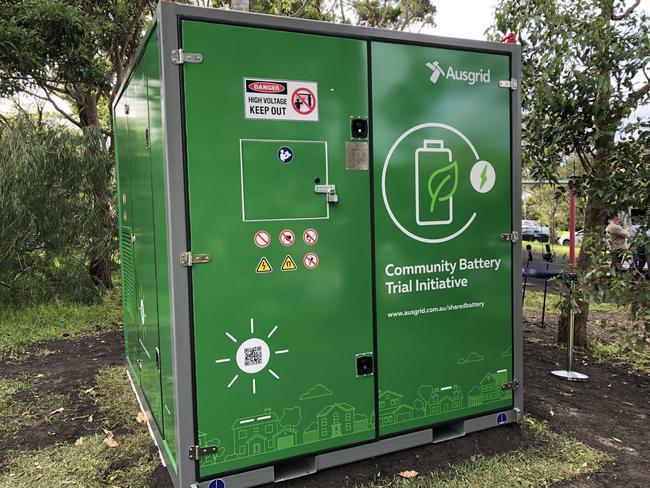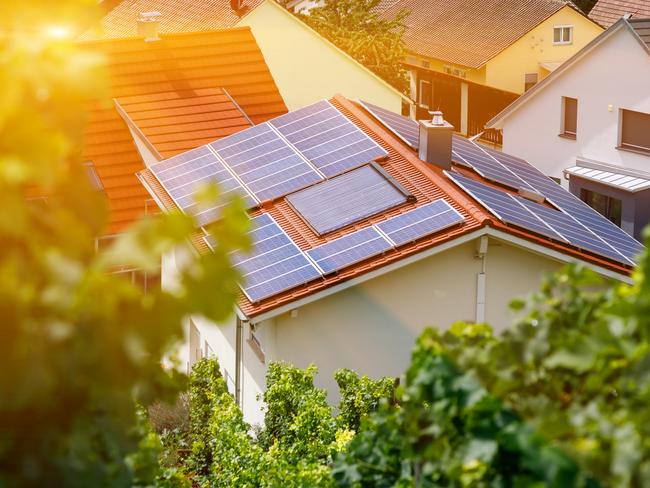Labor reveals plans to rollout 400 community batteries across Australia including Narara
Labor has promised to rollout 400 community batteries across Australia with a Central Coast suburb identified to be the first across the region. But what is it and what does it mean for your energy bills?
Central Coast
Don't miss out on the headlines from Central Coast. Followed categories will be added to My News.
The first community battery could be installed on the Central Coast if Labor are elected.
Narara has been identified as the first coast suburb to receive one of the 400 community batteries Labor has promised across Australia at a cost of $200m.
Climate Change and Energy Shadow Minister Chris Bowen was in Narara on Friday with Robertson Labor candidate Dr Gordon Reid to announce the plans that would see energy bills reduced for people with solar panels.
Mr Bowen said power bills will reduce under the plan which enables people to “better store renewable energy”.

“Here in Narara there are 4745 houses with solar panels on their roofs but less than 100 of those houses have a battery at home,” he said.
“Batteries are expensive but we can help with that. Gordon and I are announcing that an Albanese Labor government would install a community battery here in Narara. That would enable those people with solar panels on their roofs to store their energy in the community battery … to store it during the day when they are at work or school and to feed off it at night. It reduces power bills, reduced emissions, it’s good for the economy and the environment
Dr Reid said the cost of living on the coast and across Australia was skyrocketing.
“When we are door knocking and phone banking around this area, when we are talking at street stalls, cost of living is the primary concern for people. With increasing cost of living comes increased electricity prices.”

HOW DOES IT WORK?
The batteries, which costs around $500,000 each, can be installed at a park or another public space.
“It’s run by the network operator, the energy companies,” Mr Bowen said.
“People in the local areas are invited to participate, they sign up and pay a couple of dollars a week to participate. It’s voluntary.
“They just feed in. Instead of their renewable energy just feeding into the grid and being paid a small amount by the energy providers, they actually feed in and it gets noted what they are feeding in. A battery stores the energy and then they use the energy and feed off it at night. “Of course when the battery has run out they go back onto the grid but they get several hours at least of power from the battery.
Mr Bowen said people without solar panels could also benefit.
“Even if you don’t have solar panels on your roof there’s a still a capacity to participate,” he said.

“You just don’t feed in, you pay a couple of dollars extra and can access some of the energy at night. The good thing about a community battery is that it works in a number of ways in different communities fit for purpose for issues in those communities.”
He said household savings would differ for each individual with some people recording huge savings and others little depending on their energy use.
“If you’re feeding your solar energy into the grid during the day you are not getting much out of it in terms of money,” he said.
“If you are using that energy when you are tuning on the TV, cooking dinner, normally you are coming into the grid using coal fired power so that’s bad for the emissions and you are paying for it. Clearly this delivers savings.”
He said community batteries also had the benefits of providing resilience during natural disasters.
WHY NARARA?
Mr Bowen said they looked at individual areas with high solar uptake and low battery penetration.
“That was certainly the case for Narara and Gordon of course was onto me very strongly to argue that Robertson should be one of the communities reflected in the program,” he said.





